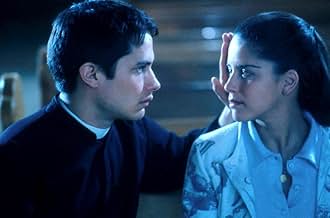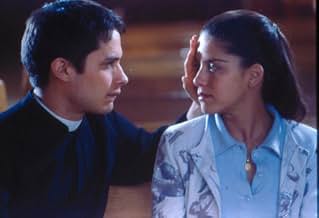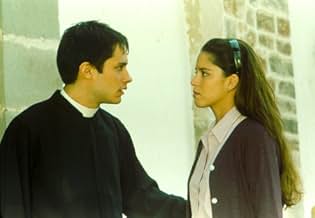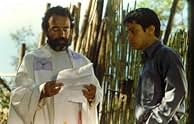IMDb RATING
6.7/10
15K
YOUR RATING
Politics and sexual passions threaten to corrupt a young, newly-ordained priest in a small Mexican town.Politics and sexual passions threaten to corrupt a young, newly-ordained priest in a small Mexican town.Politics and sexual passions threaten to corrupt a young, newly-ordained priest in a small Mexican town.
- Director
- Writers
- Stars
- Nominated for 1 Oscar
- 21 wins & 15 nominations total
Pedro Armendáriz Jr.
- Presidente Municipal Gordo
- (as Pedro Armendáriz)
- Director
- Writers
- All cast & crew
- Production, box office & more at IMDbPro
Featured reviews
I enjoyed this movie, not because it was gripping or exciting, but because of what it had to say.
I'm not completely aware of everything to do with the Catholic Church, but the controversy in this movie is a necessary one.
I've never seen a Gael Garcia movie before and I thought this was good. The most powerful part of the movie is what it leaves you with - the message at the end; the themes of confession, of sin, of mistakes, of being human.
If you can't watch something that is quite slow and is not edge of the seat stuff, then forget it. Even the music isn't very memorable. But the movie stuck in my mind.
I'm not completely aware of everything to do with the Catholic Church, but the controversy in this movie is a necessary one.
I've never seen a Gael Garcia movie before and I thought this was good. The most powerful part of the movie is what it leaves you with - the message at the end; the themes of confession, of sin, of mistakes, of being human.
If you can't watch something that is quite slow and is not edge of the seat stuff, then forget it. Even the music isn't very memorable. But the movie stuck in my mind.
`El Crimen' was not a bad film, although it was hardly worthy of accolades. While the acting was passable, the story did not move along in a provocative enough manner to thoroughly captivate its audience-- in simple terms, the movie was somewhat slow.
What is interesting to notice is the reaction that the public-- especially the Catholic public-- has had to this film. As a Catholic, it saddens me to see the amazing amount of rage focused around the lust of the film's central character, Padre Amaro. The film, on a superficial level, was rebellion against stale relics of Catholic tradition-- such as requisite chastity for clergy and the deification of inanimate objects-- that may well spell the end of the faith if they are not shed. It is on these superficial levels that Padre Amaro is decried as a criminal of the faith by the viewing public, but lust is not this priest's true crime.
Central to the film's controversy is the corruption that propels the church. The truest crime of the film is the web of cover-ups and lies that the church creates in order to propagate its cause. The church is held deep in the pockets of the drug cartel and in order to maintain their stability, the majority of the church leadership, from the bishop down to the sacristans,
are quite comfortable with, at worst, lying and falsifying evidence or, at best, looking the other way. The crime of Padre Amaro is not so much that he acted upon his human impulses as that he accepts the corruption of the church by participating in its lies and creating lies of his own.
Unfortunately, this film's only exposé is not the corruption of the church, which has become more and more evident in recent times, but the faithful church body's willingness to pretend that none of this goes on. One of the most terrifyingly ironic cries of foul against this film, as evidenced in many of these reviews, is, `Priests would never act that way!' How can one, in today's climate, make such assertions? While this film should, in an ideal world, be objectionable, the current outcry by supposedly devout Catholics represents a denial of epidemic proportions.
If one would set aside one's group think for two hours while watching this film, one might gain a perspective of the church that our priests do not offer in their Sunday morning Masses. This film may not represent what we would like our church to be, but it does represent what our church is. If we continue to pretend that the current state of affairs of our faith is acceptable, then el crimen de Padre Amaro will also be our crime: complacence.
What is interesting to notice is the reaction that the public-- especially the Catholic public-- has had to this film. As a Catholic, it saddens me to see the amazing amount of rage focused around the lust of the film's central character, Padre Amaro. The film, on a superficial level, was rebellion against stale relics of Catholic tradition-- such as requisite chastity for clergy and the deification of inanimate objects-- that may well spell the end of the faith if they are not shed. It is on these superficial levels that Padre Amaro is decried as a criminal of the faith by the viewing public, but lust is not this priest's true crime.
Central to the film's controversy is the corruption that propels the church. The truest crime of the film is the web of cover-ups and lies that the church creates in order to propagate its cause. The church is held deep in the pockets of the drug cartel and in order to maintain their stability, the majority of the church leadership, from the bishop down to the sacristans,
are quite comfortable with, at worst, lying and falsifying evidence or, at best, looking the other way. The crime of Padre Amaro is not so much that he acted upon his human impulses as that he accepts the corruption of the church by participating in its lies and creating lies of his own.
Unfortunately, this film's only exposé is not the corruption of the church, which has become more and more evident in recent times, but the faithful church body's willingness to pretend that none of this goes on. One of the most terrifyingly ironic cries of foul against this film, as evidenced in many of these reviews, is, `Priests would never act that way!' How can one, in today's climate, make such assertions? While this film should, in an ideal world, be objectionable, the current outcry by supposedly devout Catholics represents a denial of epidemic proportions.
If one would set aside one's group think for two hours while watching this film, one might gain a perspective of the church that our priests do not offer in their Sunday morning Masses. This film may not represent what we would like our church to be, but it does represent what our church is. If we continue to pretend that the current state of affairs of our faith is acceptable, then el crimen de Padre Amaro will also be our crime: complacence.
In my opinion, the best thing about El Crimen del Padre Amaro is Vicente Leñero's script - updating a story from 1875 without losing the magic scenes created by Eça de Queiroz so long ago. Gael Garcia Bernal keeps proving that his talent is solid and we can expect much more from him in the future. Another good surprise is Ana Claudia Talancón, not only for her astonishing beauty, but also for a great performance as Amelia. The cast is very good and the plot, yet polemical, gives a lot to think. Again, by updating the old Portuguese story to a contemporary Mexico and inserting current issues like the relation between church and drug dealers, El Crimen del Padre Amaro raises some relevant questions about celibate, religious ethics and hypocrisy. As written in 1875, "loneliness is the greatest sin".
This "modern" adaptation from the classic novel written by Portuguese writer Eça de Queiroz in 1875 is very disappointing. The daring and exquisite novel was turned into a Mexican melodrama. Gael García Bernal ("Amores Perros", "Y Tu Mamá También", "La Mala Educación", "The Motorcycle Diaries") is a talented actor, but even his charisma couldn't conceal the flaws of the movie.
Eça de Queiroz is a very esteemed writer at Brazilian schools, and his importance for Portuguese Literature is incontestable; he deserved more respect. I just can't understand why this "El Crimen del Padre Amaro" was so praised by most critics. Anyway, it's sad to see that such a strong book was so poorly adapted. It isn't horrible, but could have been too much better. 4 out of 10.
"One of the most controversial films ever made"? NO WAY!
Eça de Queiroz is a very esteemed writer at Brazilian schools, and his importance for Portuguese Literature is incontestable; he deserved more respect. I just can't understand why this "El Crimen del Padre Amaro" was so praised by most critics. Anyway, it's sad to see that such a strong book was so poorly adapted. It isn't horrible, but could have been too much better. 4 out of 10.
"One of the most controversial films ever made"? NO WAY!
Crimen del Padre Amaro
The film Crimen del Padre Amaro is set in Los Reyes, Mexico in 2002. In Mexico by 2002, a continuing economic, political, and social crisis was spiraling deeper and deeper. The chaos was caused by a debt problem and the system of dependent capitalism the debt produced. "Between 1994 and 2000 average wages declined 21 percent" (Keen 317). By 2002, Mexico had become more and more dependent primarily upon the United States, its foreign export, and its investment-capital markets. Despite these setbacks, Mexicans always had something to fall back upon and to look to for support: the Catholic Church.
The Catholic Church is the main focus in the movie Crimen del Padre Amaro. There are no specific events that occurred within the movie that occurred in real Mexican history; however the events that do occur are believable and likely happened. Within the film, Padre Benito is taking money donations from a local drug lord to help fund a new hospital. Since there are many drug lords in Mexico it is not unbelievable that two of the most powerful groups in Mexico are the drug lords and the Church officials. It makes sense that they would overlap at some point, however I am sure that this scenario does not occur in all areas of Mexico. The director could have made it a little clearer that the drug lord was an actual drug lord; it was a little confusing with the mayor and the drug lord to keep each person separate. Another point of corruption within the Church is the fact that both Padre Benito and Padre Amaro have sexual relations with females despite their celibacy vows. This is not surprising at all, since it has become public knowledge that many Catholic priests have had sexual relations with people in recent years. The director could have shown more of the economic crisis and guerrilla warfare situations more, because they were a little confusing if one did not know or look into what was going on in Mexico in 2002.
The film is well made and attention-grabbing. The plot is a little confusing at first, as most movies are, however it all becomes much clearer and focused as the movie continues. In the beginning of the movie, Padre Amaro is seen as the good guy, who everyone wanted to succeed; however, by the end of the film, I looked upon Padre Amaro with complete disgust. Ironically, Padre Benito, I felt, was a horrible, corrupt priest in the beginning, and by the end I liked him much more than ever before. Padre Amaro was so young and yet he ended up being the most selfish and corrupt of all the priests in the community. Crimen del Padre Amaro is a very interesting film that is entertaining and worth watching to see what modern-day rural Mexico is like.
The film Crimen del Padre Amaro shows an interesting outlook of the Catholic Church and the corruption that exists within the Church in Mexico. It is very gripping and definitely worth watching. Although there are parts that can be confusing, it is fascinating to see how rural and "backward" parts of Mexican life can be. I would recommend viewing this movie and on a scale of 1-10, I would give it a 7.
Works Cited: Keen, Benjamin and Keith Haynes: A History of Latin America. New York: Houghton Mifflin Company, 2004.
The film Crimen del Padre Amaro is set in Los Reyes, Mexico in 2002. In Mexico by 2002, a continuing economic, political, and social crisis was spiraling deeper and deeper. The chaos was caused by a debt problem and the system of dependent capitalism the debt produced. "Between 1994 and 2000 average wages declined 21 percent" (Keen 317). By 2002, Mexico had become more and more dependent primarily upon the United States, its foreign export, and its investment-capital markets. Despite these setbacks, Mexicans always had something to fall back upon and to look to for support: the Catholic Church.
The Catholic Church is the main focus in the movie Crimen del Padre Amaro. There are no specific events that occurred within the movie that occurred in real Mexican history; however the events that do occur are believable and likely happened. Within the film, Padre Benito is taking money donations from a local drug lord to help fund a new hospital. Since there are many drug lords in Mexico it is not unbelievable that two of the most powerful groups in Mexico are the drug lords and the Church officials. It makes sense that they would overlap at some point, however I am sure that this scenario does not occur in all areas of Mexico. The director could have made it a little clearer that the drug lord was an actual drug lord; it was a little confusing with the mayor and the drug lord to keep each person separate. Another point of corruption within the Church is the fact that both Padre Benito and Padre Amaro have sexual relations with females despite their celibacy vows. This is not surprising at all, since it has become public knowledge that many Catholic priests have had sexual relations with people in recent years. The director could have shown more of the economic crisis and guerrilla warfare situations more, because they were a little confusing if one did not know or look into what was going on in Mexico in 2002.
The film is well made and attention-grabbing. The plot is a little confusing at first, as most movies are, however it all becomes much clearer and focused as the movie continues. In the beginning of the movie, Padre Amaro is seen as the good guy, who everyone wanted to succeed; however, by the end of the film, I looked upon Padre Amaro with complete disgust. Ironically, Padre Benito, I felt, was a horrible, corrupt priest in the beginning, and by the end I liked him much more than ever before. Padre Amaro was so young and yet he ended up being the most selfish and corrupt of all the priests in the community. Crimen del Padre Amaro is a very interesting film that is entertaining and worth watching to see what modern-day rural Mexico is like.
The film Crimen del Padre Amaro shows an interesting outlook of the Catholic Church and the corruption that exists within the Church in Mexico. It is very gripping and definitely worth watching. Although there are parts that can be confusing, it is fascinating to see how rural and "backward" parts of Mexican life can be. I would recommend viewing this movie and on a scale of 1-10, I would give it a 7.
Works Cited: Keen, Benjamin and Keith Haynes: A History of Latin America. New York: Houghton Mifflin Company, 2004.
Did you know
- TriviaThis movie began creating controversy even before it was released. Several groups, most of them related to the church, tried to ban it. They did not succeed; instead, tickets were sold out on opening weekend.
- GoofsAmaro gets beaten up by Ruben and receives some bruises in his face. A little later, when he meets Amelia in the church, the bruises are gone.
- Quotes
Father Amaro: Tell me your sins, child.
Amelia: You already know them. And your sins?
- Crazy credits"In memoriam Paco Rabal"
- ConnectionsFeatured in The 60th Annual Golden Globe Awards (2003)
- How long is The Crime of Padre Amaro?Powered by Alexa
Details
- Release date
- Countries of origin
- Official sites
- Language
- Also known as
- The Crime of Padre Amaro
- Filming locations
- Production companies
- See more company credits at IMDbPro
Box office
- Budget
- $1,800,000 (estimated)
- Gross US & Canada
- $5,717,044
- Opening weekend US & Canada
- $504,681
- Nov 17, 2002
- Gross worldwide
- $26,996,738
- Runtime
- 1h 58m(118 min)
- Color
- Sound mix
- Aspect ratio
- 1.85 : 1
Contribute to this page
Suggest an edit or add missing content






































